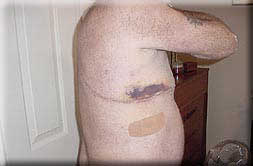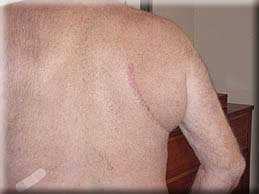Rodney Steenbergen is a 63 year-old former machinist's mate with nineteen years of service in the U.S. Navy, most of it spent at sea, and another 20 years of pipeline work all over the continental United States and Alaska.
After all these years of hard work all around the world, Rodney and Linda, his wife of 39 years, finally settled down in Glasgow, Kentucky seven years ago. Both are from this bucolic area of southeast Kentucky. They made a neat and tidy home. Rodney filled one room with pictures, brass bells and other nautical memorabilia from his service. They took pride and solace in their nineteen year-old grandson's naval service. Life was very good.
Then, suddenly, on Saturday, September 16, 2000 , the Steenbergens' orderly and happy existence disintegrated.
Rodney's troubles began that evening, when he suffered chest pain so severe he thought he was having a heart attack. He went to the emergency room of T.J. Samson Hospital in Glasgow, Kentucky. Chest films taken at T.J. Samson showed an egg-sized spot on the right lung. Mr. Steenbergen gets a yearly check-up with chest films through the V.A. Hospital, and the spot was not present on the chest film in March, 2000.
Rodney was referred to a Dr. Thomson, a pulmonologist in Bowling Green, Kentucky. Dr. Thomson ordered a PET scan to be conducted at Bowling Green Medical Center. The PET scan showed the presence of an egg-shaped tumor in the right upper lobe. On October 2, Dr. Thomson attempted a bronchoscopy with biopsy (via the nose), but was unable to biopsy the tumor. Dr. Thomson performed a needle biopsy on October 5. Dr. Thomson told Rodney that he had lung cancer, and referred him to a thoracic surgeon, Dr. Robert Franklin, also of Bowling Green.

Rodney consulted with Dr. Franklin on October 10. Dr. Franklin felt he could remove all of the tumor by removing the entire right lung. During the surgery on October 16 at Bowling Green Medical Center, Dr. Franklin found that the tumor was "webbed up" in the lung and attached to the spine as well. Based upon this finding, Dr. Franklin aborted the procedure without removing the lung, while harvesting tissue for pathological testing.
Dr. Franklin told Rodney that he might have mesothelioma. On Tuesday, October 24, Rodney returned to Dr. Franklin to have the staples from his surgery removed, at which time Dr. Franklin advised that pathology had confirmed "twelve different ways" the diagnosis of malignant mesothelioma. Rodney was told that his cancer is related to asbestos.
Rodney was referred to a Dr. Branham, an oncologist at the Graven Gilbert Clinic in Bowling Green. However, Rodney spent days researching his treatment options on the Internet, and felt that his hopes for survival rested elsewhere. He reached out to M.D. Anderson Cancer Center in Houston, Texas, and to the Cancer Therapy and Research Center ( CTRC ) in San Antonio, Texas. Initially, Rodney experienced frustration dealing with both institutions, and in trying to decide which was right for him.
He eventually chose CTRC after one of his local doctors contacted Stephanie Hodges, who helps run the clinical trials at CTRC. (Ms. Hodges strongly recommends that any patients considering one of the clinical trials at CTRC have their treating oncologist contact her directly, so that she may efficiently determine their eligibility). Rodney was very interested in trying ALIMTA (R) (pemetrexed disodium), Eli Lily's experimental multi-targeted antifolate. Although other cancer centers were offering "blind" trials with ALIMTA, where half the patients did not receive the drug, all within the CTRC's trial received the drug. He was also very impressed with Ms. Hodges' cordial manner.

Rodney and Linda love to travel, and have been to all 50 states. Also, Linda's two sisters live nearby and are both single. One of the sisters lost her husband to a pancreatic illness. Linda and Rodney joke that he has three wives, not one. So in mid-November, when it came time to seek admission to CTRC's ALIMTA trial, Rodney, Linda and her two sisters piled into the Steenbergens' mobile home for the drive to San Antonio.
The trip was arduous for a man on morphine. The Steenbergens were deeply impressed by the caring attitude of the staff at CTRC, and grateful that CTRC admitted Rodney to the trial, which combines Alimta with CPT-11. Rodney suffered nausea, vomiting and a rash during the chemotherapy, but he bounced back pretty quickly. He recently completed his second round of chemotherapy in San Antonio, and again suffered nausea, as well as severe night sweats. However, his weight is stable, and he senses that his tumor is shrinking.
Linda and her two sisters have rallied around Rodney, as have his friends and neighbors. The phone rings continually with well-wishers. We join that throng in wishing the Steenbergens the very best in their search for hope, and for life.
*** POSTED JANUARY 8, 2001 ***
An Update -- 7/23/02
A few weeks ago, Rodney was treating with Taxotere on a compassionate basis. However, his oncologist gave him the bad news that his tumor had grown, and he had to discontinue the treatments.
Desperate, Rodney and Linda began searching again for new hope. Rodney applied for a new chemotherapeutic agent in clinical trials called Decitabine and will learn shortly if he has been accepted into the trial. We will keep you posted on the progress of this persistent couple.
Mr. Steenbergen passed away on December 1, 2002

